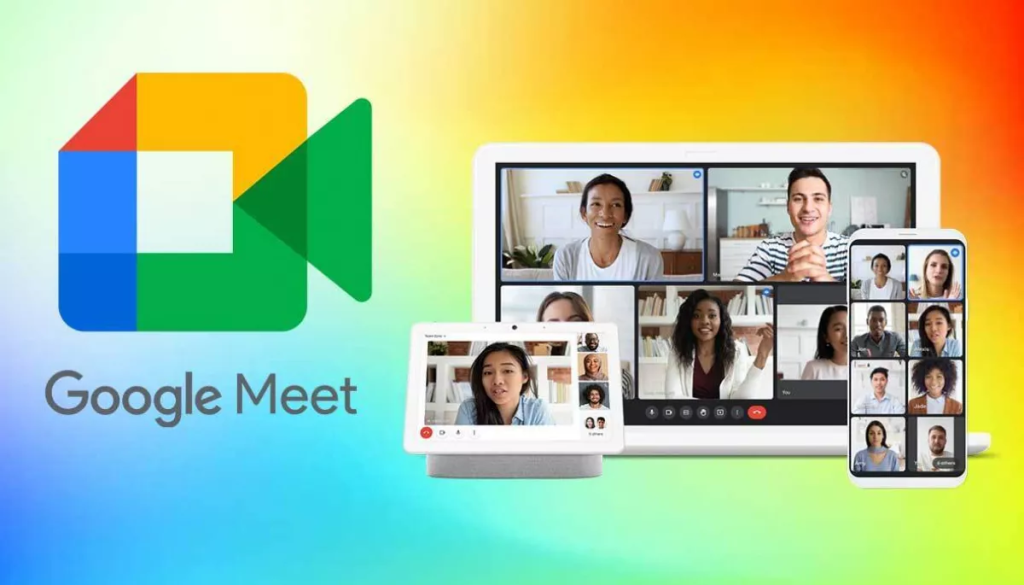Table of Contents
Have you ever been in a video call and couldn’t understand what someone was saying because they were speaking a different language?
Now, imagine this: You’re talking in English, and your friend hears it in Spanish — instantly. Sounds like magic, right? Well, it’s not magic. It’s Google Meet’s new real-time speech translation feature.
In this blog, we’ll explore what real-time speech translation means, how Google Meet is using it, and why it matters for people, schools, and businesses around the world.
What Is Google Meet?

Google Meet is a video calling tool, kind of like Zoom or Microsoft Teams. You can use it to:
- Join online meetings
- Attend virtual classes
- Have face-to-face calls with friends and coworkers
- Share screens and documents
It works on phones, tablets, and computers — and it’s used by millions of people every day.
What Is Real-Time Speech Translation?
Let’s break it down:
- Real-time means it happens immediately, with no waiting.
- Speech translation means converting spoken words from one language into another.
So, when someone speaks in English, real-time speech translation changes their words into another language, like French or Hindi, while they are still talking.
You don’t need to pause, type, or wait for subtitles. The translation happens live during the conversation.
How Google Meet’s New Feature Works
Google Meet already had live captions — text on the screen that shows what people are saying. Now, it’s adding live translated captions, which means:
- You speak in your language
- The person watching sees captions in their language
- The translation happens as you speak
For example:
- A teacher in the U.S. speaks in English
- A student in Japan sees Japanese subtitles in real time
- No need for extra tools or translators
This makes meetings, classrooms, and events easier for people who don’t share the same language.
Why Is This Important?
This feature might sound like a cool tech trick, but it’s a big deal. Here’s why:
1. Breaks Language Barriers
People from different countries can now work or learn together, even if they don’t speak the same language.
2. Helps Schools and Students
Students can learn in their native language, even if the teacher speaks a different one.
3. Improves Global Business
Companies can work with international partners more easily — no need for human translators in every meeting.
4. Supports Accessibility
People who are hard of hearing or prefer reading over listening can follow along better.
5. Saves Time and Money
There’s no need to hire a translator or create subtitles for every video.
Where Can This Be Used?
This technology is useful in many places:
| Use Case | Example |
| Education | A student in Brazil joins a US classroom and understands through translated captions |
| Healthcare | A doctor speaks English, but the patient sees Spanish subtitles during a virtual visit |
| Remote Work | A global team holds a meeting, and each person sees the speech in their language |
| Events & Webinars | An international speaker presents in French, and viewers read English captions live |
Languages Supported
Google hasn’t confirmed the full list yet, but it will start with popular languages like:
- English
- Spanish
- French
- German
- Portuguese
- Hindi
- Japanese
More languages will likely be added as the system improves.
What Are the Challenges?
Of course, no technology is perfect. Here are a few things to consider:
- Translation mistakes: AI might not always get complex words or slang right
- Accent issues: Some accents or fast talking might confuse the system
- Internet needs: You’ll need a good connection for smooth performance
- Language limits: Not all languages are supported yet
Still, for everyday use, this tool is already powerful and helpful.
Real-Life Example: A School Goes Global
Imagine a virtual classroom with students from India, Mexico, and South Africa. The teacher speaks English, but each student sees translated captions in their language.
Thanks to Google Meet, they can all learn together, ask questions, and understand lessons without needing separate teachers or translators.
This shows how technology can create equal learning opportunities for everyone.
What Makes Google’s Tool Different?
While other video tools like Zoom or Microsoft Teams offer captioning, Google Meet’s real-time speech translation is built directly into the system, meaning:
- No need to install anything extra
- It works in the same place where you already meet
- It feels smooth and natural
Plus, Google is known for its strong language tools, like Google Translate, which means the system gets smarter over time.
The Future of Communication
Real-time translation is just the beginning. Shortly, we may see:
- Voice-to-voice translation: You speak English, and the other person hears Spanish.
- Offline translation: Meetings translated without needing the internet.
- Translation for signs and menus: Using cameras in real-time.
As AI gets better, communication between people will become easier, no matter where they live or what language they speak.
Conclusion
Google Meet’s new real-time speech translation feature is a big step forward for global communication. It helps people understand each other better, learn faster, and work together, no matter what language they speak.
Whether you’re a student, teacher, doctor, or business owner, this technology can make your online meetings more useful and inclusive.
In a world that’s more connected than ever, tools like this remind us that language should never be a barrier to learning, working, or understanding.